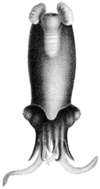Ram's Horn Squid
|
|
| Ram's Horn Squid | ||||||||||||||||||
|---|---|---|---|---|---|---|---|---|---|---|---|---|---|---|---|---|---|---|
 | ||||||||||||||||||
| Scientific classification | ||||||||||||||||||
| ||||||||||||||||||
| Binomial name | ||||||||||||||||||
| Spirula spirula (Linnaeus, 1758) |
Ram's Horn Squid (Spirula spirula) is a unique and peculiar species of mollusc which constitutes a family (Spirulidae) and order (Spirulida) by itself. Live specimens are very rare because they are deep dwellers. It is also known as Little Post Horn Squid or simply by its genus Spirula.
Description
Spirula have a squid-like body between 35 mm and 45 mm long. They are decapods, with 8 arms and 2 longer tentacles, all with suckers. The arms and tentacles can all be withdrawn completely into the mantle. The most distinctive feature is the buoyancy chamber, an internal shell in the shape of an open planispiral (a flat spiral where the coils do not touch each other). The chamber keeps the spirula in a vertical, head-down attitude. The posterior also contains a light-emitting organ that can glow for hours at a time.
Habitat
Spirula inhabit continental slopes with water depths of 1000 - 2000 metres. By day they dwell at a depth of 550 - 700 metres and sometimes as deep as 1000 metres. By night, they rise to a depth of 100-300 metres.
Distribution
Most sources cite them as tropical, and they are observed to be plentiful in the seas around the Canary Islands. However, significant quantities of shells from dead spirula are washed ashore in temperate regions, such as the western coasts of South Africa and New Zealand. These have possibly been carried long distances by ocean currents.de:Posthörnchen
